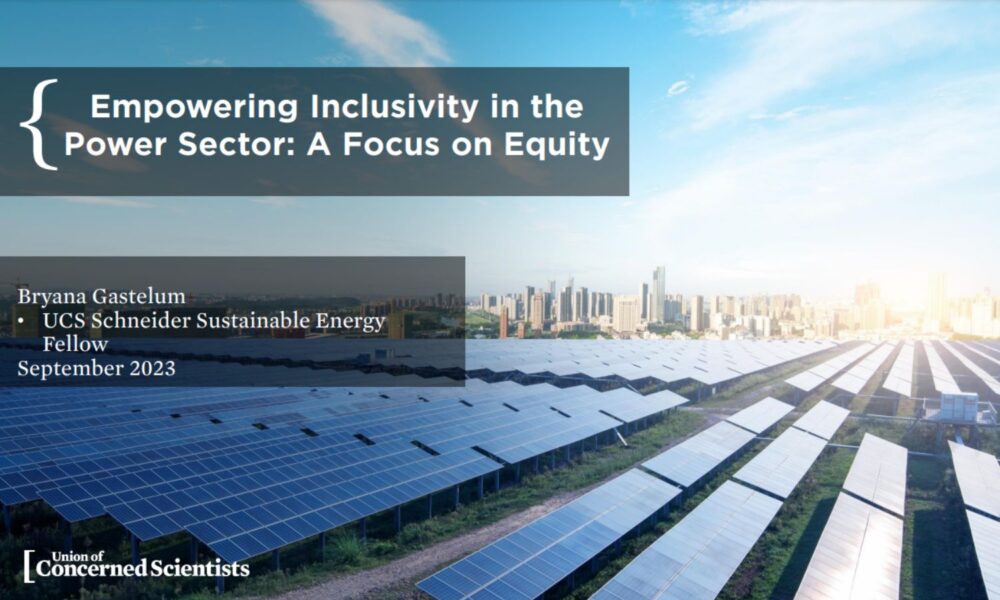Like many other public-serving institutions throughout society, electricity and gas utilities are facing calls to be more equitable in their operations, planning, and treatment of customers.
But exactly what is energy equity and what does it mean for utilities to address energy equity directly or consider energy justice more broadly in their work?
Energy equity involves confronting the asymmetric suffering faced by the most disadvantaged groups in our communities in the context of access to energy resources.
For example, think of how unequal burdens manifest themselves amid Danger Season, when a range of climate impacts hit increasingly hard. It is a time when electricity becomes more expensive and low-income households face decisions that may threaten safety, health, and well-being—such as whether they should forgo food and medicine or keep homes at unhealthy temperatures.
Energy equity also means thinking about the unequal distribution of energy system costs in our country and how that directly reflects historical harms enacted through policy and siting of polluting facilities that have sacrificed communities of Black, Latinx, Native, low-income, and immigrant groups for decades. Ensuring the most historically disadvantaged groups aren’t bearing an unequal burden for the cost of cooling themselves during climate change-caused heat waves is a clear example of energy equity that our electric and gas utilities could address.
How are energy equity and energy justice connected?
Energy equity lives under the umbrella of energy justice. To have energy justice means to invest in communities, acknowledge structural injustices, and work to empower disadvantaged communities.
An energy justice framework outlines goals and processes of achieving equity through tenets of justice: procedural justice, distributive justice, recognition justice, and restorative justice.
Governmental agencies and utilities involved in the energy sector can pair an energy justice framework with meaningful community engagement to assess their actions and decisions and realize the benefits of energy equity for their constituents.
In the process of striving for equity in the emerging clean energy transition, I must emphasize that livelihoods dependent on the power sector are on the line. During the shift from fossil fuels to renewable energy sources, it is crucial not only to prevent certain groups from being excluded, but also to guarantee that disadvantaged communities can step into positions of leadership and ownership, and that past injustices are remedied.
Community engagement is a crucial part of energy justice
For me and the communities I come from, this fight for energy justice and energy equity is incredibly personal.
I grew up and still live in the cities of Richmond and San Pablo in Northern California’s Bay Area, two working-class communities made up predominantly of people of color. They have borne the consequences of sharing more than 100 years of history with the Chevron Richmond oil refinery operating nearby.
In 2019 and 2020, I served as a member of a committee involved in the implementation of California’s Assembly Bill 617. That law created the state’s Community Air Protection Program focused on reducing exposure in communities most impacted by air pollution. As a resident member of the AB 617 Community Air Monitoring Steering Committee, I witnessed glimpses of community engagement in action and the progress towards energy justice and energy equity that such engagement can create.
Through this process, residents, alongside industry partners, local government, and community-based organization representatives, gathered to discuss air monitoring and emission reduction strategies. The steering committee provided a strong example of procedural justice, in which the decision-making body made an intentional effort towards community inclusivity. Translation services, daycare, and member compensation were provided at monthly committee meetings.
Though AB 617 includes positive examples of community engagement, questions persist on whether the program can produce equitable results. For example: How was AB 617 perceived by other members of the community? Is AB 617 a productive strategy for reducing emissions in environmental justice communities? How has the program considered action toward community leadership/ownership over mere engagement? These questions highlight the fact that equity is a process of iteration, one that requires consistent reflection, feedback, and revision.
Weaknesses of the AB 617 program reveal gaps in the program’s design: Backlash from community members includes dislike over corporate influence in the process and delays in the creation and implementation of the emission reduction plan. Millions of dollars, tied back to the state’s cap-and-trade auctions, are funneled into the AB 617 process, yet funding is unreliable, and only a small number of communities are picked to participate in AB 617, leaving communities to compete for resources.
The former policy and political director for the California Environmental Justice Alliance, Katie Valenzuela, critiques the lack of accountability from air districts that prevent communities from creating strong plans. Valenzuela rightfully questions whether AB 617 is the right vehicle to address environmental justice concerns. She said in 2021, “What was done functionally was exactly what everybody was worried about. We’ve made it more complex for communities to advocate.”
Though the focus of AB 617 is emissions reduction, its takeaways can be applied to the broader energy transition space.
Utilities have a role to play in ensuring energy equity
Utilities will have influence over the pace and direction of the emerging energy transition. Particularly in the power sector, utilities play a pivotal role in ensuring customers and communities have access to clean, reliable, and affordable electricity.
But how can utilities get it right and ensure not only access but also equity? Especially considering that the practice of equity can vary widely in different communities with diverse histories and energy needs.
One thing utilities can do is take lessons from the experience of frontline groups in community processes, like that of AB 617. It is imperative they center equity in advancement towards a Just Transition.
This slide deck I created while serving as a Schneider Sustainable Energy Fellow at the Union of Concerned Scientists this year provides information on the energy justice framework and how it can be applied specifically to utilities. The deck gives examples of energy equity approaches in other contexts and how those insights can be translated into the utility space. Insights, takeaways, and resources provide utilities and other stakeholders with a strong skeleton to build out future energy equity initiatives.

While many utilities are beginning to address equity through affordability programs and demand-side management, ensuring the longevity of equity requires a comprehensive strategy. Applying frameworks such as the tenets of energy justice can help utilities develop a robust equity strategy.
Recommendations include:
- creating an organization-wide equity plan
- directing investment of resources to community-based organizations already doing engagement work
- forming an equity working group within the company
- issuing public-facing accountability reports
To be equitable, utilities must incorporate transparency and accountability
To make progress in advancing equity, utilities must implement frameworks that prioritize transparency and accountability.
Incorporating transparency involves specifying the benefits delivered for specific communities, detailing related investments and projects, using energy justice metrics to assess impact, tracking benefit distribution, and maintaining a regular reporting process.
Integrating accountability includes establishing a company-wide equity strategy accessible to the public and outlining methods to address energy justice principles.
By intertwining transparency and accountability into their frameworks, utilities can make significant strides towards fostering equity and energy justice in their operations and initiatives.
Energy equity is an iterative process. My experience with AB 617 shows the potential for community engagement in amplifying and supporting community visions. Utilities can draw from principles and recommendations like those I’ve outlined, but most importantly the key is for them, and advocates like us, to stay committed. The energy transition is inevitable, justice is not. Energy equity is essential in building an infrastructure that puts communities first.

